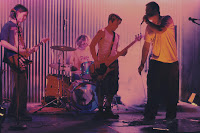I recently came across a post on
CD Baby's DIY Musician blog about the
Top 5 Mistakes Musician's Make With Their Live Show that I thought was great. The post was by
Tom Jackson, who specializes as a live show producer, which is something that we need a lot more of. I've written a lot on this subject in
How To Make Your Band Sound Great, but Tom has some tips that I'd never thought of.
Here are the 5 mistakes that many bands make:
1. “Winging it” is mistaken for spontaneity. I constantly run across the attitude of “Dude, I’ve got to be spontaneous – I can’t rehearse my show!” Sometimes my reply is “Awesome – but if you really want to be spontaneous, make up the song right in front of the audience… that’d be real awesome!”
Instead of learning the right way to be spontaneous onstage, they mistake “winging it” for spontaneity! They jump around onstage and try different things, hoping something will work. And here’s the irony – when they do something verbally, visually, or musically in front of the crowd one night that gets a great response, they do that same thing the next night, too.
So where did the spontaneity go? They do the same thing they did the first night because it worked! That’s because spontaneity and winging it are 2 different things. In fact, if we rehearse right, we will leave room for spontaneity in our show.
2. Practice is mistaken for rehearsal. But most artists don’t realize there is more to getting a live show ready than just “practicing” the music. Rehearsal involves the musical, the visual, the verbal, the rearranging of songs that were written for radio so they work live, and more.
3. Song arrangements intended for radio are mistakenly used for live shows. We know the rules for getting played on radio: 3-4 minutes long, a certain form, short intro, etc. But a live show and radio are 2 different things! Your audience’s expectations are different at a club or concert hall than they are when they turn on a radio. If you play your songs just as they were recorded for radio, you’re making a big mistake. Those songs need to be rearranged to create a compelling live show.
4. Artists assume the audience wants them to sing songs or play music. Audiences go to a live concert for 3 reasons: to be captured & engaged, to experience moments, and to have their lives changed in some way. As musicians, we make the mistake of thinking (partly because it’s us, our adrenaline is flowing, and we’re playing our own music) that we are awesome onstage and there are “moments” all through our songs. And there are – for us. But we need to create moments for our audience!
5. Artists’ songs all look the same, even though they don’t sound the same. As an artist you know your songs are all different. They have different themes, melodies, rhythms, and tones. They don’t sound the same. But (for 95% of artists out there) they look the same. You need to be as creative with your show as you are with your music. Communication with your audience is 15% content, 30% tone or emotion, and 55% is what they see. So it can be a real problem if your songs all look the same, because to an audience that doesn’t know who you are, your songs will start sounding the same. Most artists typically do the same thing onstage over and over for every song: the same movement from the same place… big mistake!
This last point I think is especially important. When you go to a concert to see a world class act, the show has a dynamic flow, not only song-wise, but visually as well. That's something completely missing with most club bands, but that's perhaps the most important part of a live show.
This is an excerpt from the original article, so be sure to
check out the whole thing.
----------------------------------



